|
Irkutsk was founded on the place of the rivers
Irkut and Angara confluence in 1661. At first, it was a wooden fortress (ostrog), which
was growing fast, and in 25 years it received a city status. |
|
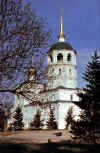 |
The city foundation is connected with the
territory, close to the city central square – the Kirov square. This is the place where
wooden buildings appeared. Today there is almost nothing reminiscent of it. Church stone
buildings were constructed much later. The earliest church among them was the Spassky
church, built in 1710. It was constructed on the place of a previous wooden church, built
together with the fortress. This church remembers many events in our city. For example, in
1812 when Irkutsk emergency volunteer corps went to the war against Napoleon after public
prayers, served here. Now there is one of the branches of Irkutsk regional museum in this
building. |
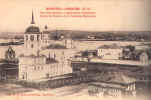
|
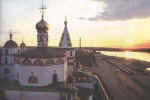 |
Behind the Spassky church there is the Bogoyavlenskii Cathedral, built in
1723. This Cathedral has been recently restored and there is church service there
presently. Both orthodox temples are considered to be the Russian architecture monuments. |
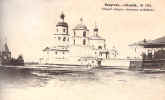 |
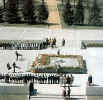 |
It is natural that an important monument for Irkutsk townspeople –
Memorial in honor of the Great Patriotic War dead – is located on the same place. It was
opened on the 30-th Anniversary of the Victory, the square was done around it. Today the
Veterans Boulevard is one of the most favorite places of recreation for the Irkutsk
townspeople. |
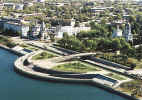 |
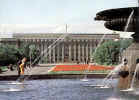 |
The Regional administration building separates
the Memorial Complex from the central square. Its architecture has a little difference
from the same buildings in other regions of the country. The places, where it stands now,
used to be a sacred one for the Irkutsk townspeople. The main Irkutsk temple – Kazanskii
– was located here before 1932, built in a Byzantine style. The cathedral was laid in
1875; the construction work was carried out for several years and it was ended in 1895.
Irkutsk Cathedral was included in a number of the tallest church buildings in Russia. It
could accommodate 5000 people, its height reached 60 meters. The temple values were highly
appreciated by contemporaries. In 1932 the Kazansky Cathedral building was blown up. |
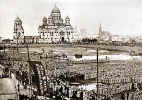 |
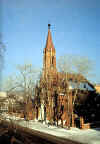 |
There is another Cathedral, which can be seen in
the area of Kirov square. This is a Catholic church (kostel), built according to an
architect I.F.Tamulevich’s project in 1884. In 1978 its building was restorated and an
organ, made by German masters especially for Irkutsk, was installed there. The organ
concerts, held here, have a large success among the Irkutsk townspeople and city guests. |
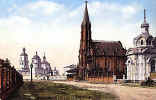 |
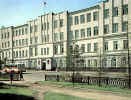 |
Another important historical building, located
on the Kirov square, is the city administration. It was a Irkutsk General-Governor’s
residential before 1838, then the building was taken by the Siberian military district
Main Staff management. The City Duma and City Administration, engaged in city economy
organization and city development problem solution, occupied the house in 1874-1920. The
city Duma was opened in Irkutsk on November 17 1787. The first city head (mayor) was a
well-known in Siberia merchant – gold-mining trader M.V.Sibiryakov (1744-1814). Later
this post was taken by the same active people. Their names were kept by Irkutsk chronicles
pages: Xenofont Sibiryakov, E.A.Kuznezov, K.P.Trapeznikov, I.L.Medvednikov, V.N.Basnin,
P.E.Katyshevzev and other honored citizens. Within the City Duma walls many important city
development decisions were passed. For example, Irkutsk State University foundation
necessity resolution was endorsed in 1916 there. During the Soviet power the building
changed greatly – 2 more stores were added, the front was widened. Therefore it is hard
to see its historical predecessor features in a present view of the city administration. |
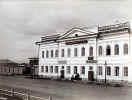 |
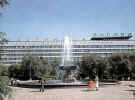 |
There is the hotel “Angara” opposite the
city administration house. The hotel was built in the 1970s on the place of a previous
six-stored house of a merchant Sivers and first public library in Irkutsk. The library was
founded in 1778 by Irkutsk governor F. Klichka and local merchant class representatives,
including B.N. Basnin and G.I. Shelikhov. 2000 rubles were allocated for this purpose by
Catherine the Great (II). |
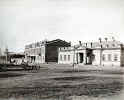 |
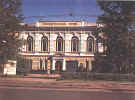 |
Lenin Street is one of the main ones in the
city. It has many signs of historical past. One can stop on some of them. Irkutsk regional
art museum is one of the biggest in the region. Its base was a collection of pictures,
icons and other art works, given to the city by an Irkutsk merchant, city head V.P.
Sukachyov. The museum was named after him in 1995. In 1999 Irkutsk celebrated the 150th
anniversary of this patron of the arts. The Irkutsk male gymnasium, one of the oldest city
civil educational establishments was placed in it. The gymnasium students (besides a set
of subjects taught in similar educational establishments of Russia) had an opportunity to
study navigation. This subject was necessary for the maritime expeditions in Northern
seas, travels to the American coasts and lake Baikal navigation. This gymnasium had one of
the first “Japanese” classes. This class consisted of the students, whose instructors
were “native” Japanese, sailors from the ships, wrecked off the northern-eastern
Russian coast. |
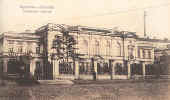 |
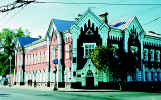 |
There is an eye problem clinic of the Medical
University opposite the Art museum. Today it is one of the leading such profile medical
establishments in the region. The roman style building was built in 1883 on the funds of a
merchant I. Bazanov. It was so called Bazanov educational house in this building. The
babies, abandoned by mothers, and foster-mothers took care of them until the babies
reached 4 month age. Then the babies were given to the families. Guardians received 6-8
rubles per month from Bazanov’s funds. 8 years old children were taken into the
orphanage in order they could master reading and crafts. This educational house also
included maternity house and gynecological ambulatory clinic. |
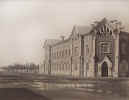 |
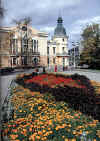 |
The Kirov regional policlinic, located at the corner of
Lenin and Karl Marx streets, has interesting history. The house was built in 1910-1912 in
modern style by Irkutsk architect V.I. Kolyanovskii’s project. Before 1917 Irkutsk
branch of Russian-Asian bank was in this building. That bank was one of the biggest
joint-stock pre-Revolutionary Russian bank. Its budget was 35 mln. rubles. In Siberia the
bank gave credits to such industrial branches as gold and coal-mining, flour-milling,
leather-processing and sawmill. It invested bread trade. In 1914 there was conference
about Northern sea road pioneering. |
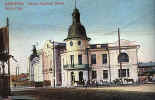 |
|
The Karl-Marx street is the second main street in the
city. It was called “Bolshaya” (Big) before 1917. The street appeared in the second
part of the XVIII century when palisade (wall made of top-sharpened logs, dug into the
earth) was dismantled. The palisade used to be natural border of the city between the
Angara and Ushakovka rivers. We can point out only several buildings, connected with the
city history, on this street with rich past. |
|
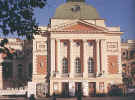 |
The city theater was built in 1894-1897 by St.
Petersburg architect V.A. Shreter. Irkutsk General-Governor A.D.Goremykin was an initiator
of that building construction. The Irkutsk townspeople gave their personal savings to its
construction. The theater was opened on Sep 2 1897 with a performance “Inspector”.
There were many famous actors in Russia on the stage of the theater, such as V.
Komissarzhevskaya, V.Dalmatov, A.Yablochkina, K.Varlamov, L.Soblinov and others. Several
years ago a museum was opened in the theater, which recorded many bright pages of the city
theater history. In 1999 the theater building was reconstructed and renewed on the
initiative of Irkutsk region governor B.A.Govorin. The theater space expanded; near-by
square was improved. |
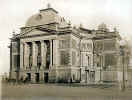 |
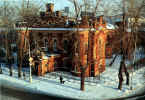 |
The Mauritian style building located at the corner of the Karl-Marx and
Gagarin Boulevard belongs to Irkutsk Regional museum. It was built in 1883-1891 and
projected by architect G.B.Rosen for hosting Eastern-Siberian department of the Russian
geographical society. It was the first research establishement in Eastern Siberia. In 1879
fire the old building perished together with rich collections and exponats, collected for
many years of the regional study. The unique library was destroyed. Many Russian and
Siberian research organizations and Irkutsk townspeople participated in a revival of the
lost. For a short time new funds were raised for new building construction, which serves
today as the city decoration. Many outstanding researchers enriched the science by new
discoveries and study work. These were V.A.Obruchev, D.A.Klemenz, N.M.Przhevalskii and
many others. The stone planks with the names of scientists, who made contribution into
Siberian exploration, are installed in the wall of the building. |
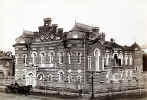 |
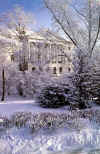 |
The White House is located opposite the museum
building. It is a famous historical and architecture monument of Irkutsk. The House was
built in the first quarter of the XIX century for Irkutsk merchant family and first city
head Mikhail Vasilyevich Sibiryakov. The house project was brought from St. Petersburg and
a famous architect Kvarengi is considered to be its author. Kvarengi projected Smolnyi
Institute in the Northern capital. Some legends about that Sibiryakov’s palace splendor
of decorations and interior were left. But after family head’s death his heirs were
forced to sell the building to the city administration. Since 1836 the White house became
a residence of Irkutsk General-Governors. It was the place where the exploration and
development strategy of the huge region, including Eastern Siberia and Far East, Russian
territories in Alaska and the Aleutian Islands, was shaped. And even Fort Ross, a small
colony of Russian people in California, was administratively placed under Irkutsk
General-Governor. The White House was visited by many famous people – the Decembrists;
renowned writers, scientists, political activists, passing through Irkutsk. The
Governor’s house was frequently visited by Innokentii Veniaminov, Aleutian Bishop. In
1891 “zesarevich” (prince) Nikolai Alexandrovich stayed in the White House. In 1909
the General-Governor’s house was visited by another Romanovs dynasty representative
Konstantin, known in Russia under the nickname “K.R.”. In 1918 Irkutsk University was
opened in the White House. Nowadays it is one of the Zonal Scientific library buildings of
Irkutsk State University. The library is one of the biggest book keeping places in
Siberia. |
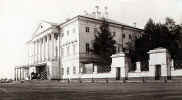 |
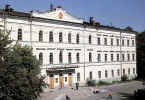 |
There is one more building of the University on the
Gagarin Boulevard. The Girlish Institute of Eastern Siberia, was located in this building
until 1920. It was the first female educational establishment in Siberia. Irkutsk
General-Governor V.Y.Rupert took an active part in its opening in 1845. The educational
process there was similar to the Smolnyi institute of St. Petersburg. Two daughters of the
decembrist S.P. Trubezkoi studied there. While leaving Siberia in 1856, he gave the
Institute a gift – a small collection of books in French. This gift is kept in the Zonal
Scientific library of Irkutsk State University now. |
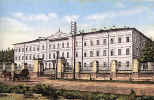 |
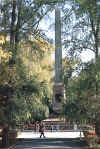 |
There is a monument, which represents obelisk made of
modern materials on the marble pedestal, done in the early XX century. It is located
opposite the White House on the Angara river bank.
In 1900 the Irkutsk City Duma (Congress) passed a resolution to mark
the end of the Siberian railroad construction by the monument to Alexander III putting up.
In 1903 the monument was laid, and it was opened in 1908. The monument project belonged to
a sculptor P.P.Bakh, who won an art competition, organized by the City Duma in 1902. The
pedestal is made of polished red Finish granite. The Tsar bronze figure (5,3 meters tall)
was cast in St.Petersburg. The monument pedestal was decorated by high relief portrayals
of Siberian conqueror Ermak, General-Governors M.M.Speranskii and N.N.Muravyov-Amurskii.
On the eastern side there is a bronze double-headed eagle, holding Tsar edict about the
Siberian railroad construction. All townspeople prepared that event: some donated money,
others took part directly in the ground and square around the monument preparation works.
In 1920 the Tsar figure was removed and destroyed, and the pedestal was empty for a long
time. In 1964 according to an architect V.P.Shmatkov obelisk was constructed. Nowadays
there are some talks about the monument restoration in its original view. |
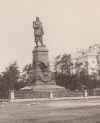 |
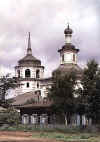 |
There is a nunnery, founded in 1693, behind the
Ushakovka river in the Znamenskii suburb (district). Its first wooden structures became
dilapidated for a short time. That is why in 1757 the stone church of the Sign of God’s
Mother was laid on the funds of a merchant Bichevin. The building process lasted long and
the nunnery was finished only in 1818 when the nuns living quarters were constructed on
the funds of merchant Chupalov. During the Soviet power the nunnery was closed, and only
the temple worked. In the present time the nunnery has been restored to life. There is a
working Sunday school there. The church-historical readings are held weekly. Since 1991
the city patron, first Irkutsk bishop Innokentii, relics have been kept in the Znamenskii
Cathedral. The Innokentii’s readings, dedicated to memory of the outstanding Orthodox
church activist, are held yearly on the initiative of Eparchy administration and a bishop
Vadim.
The nunnery walls recall many important city events. The priests and other Irkutsk
townspeople, having donated money to the church, were buried in its fence. Many famous
people were buried there too. These were an Irkutsk honored citizen V.F.Kolygin, the
Decembrists V.A.Bechasnov, P.A.Muhanov, A.A.Panov, a wife of Decembrist, E.I.Trubezkaya,
who followed her husband in Siberia. |
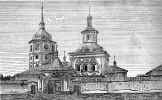 |
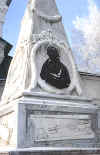 |
The most significant monument, kept on the nunnery territory, is the
monument to G.I.Shelikhov, brave navigator, founder of first Russian colonies on the North
American coast. He died in Irkutsk in 1795. In 1800 his widow put up the monument to him,
which represents a stone pyramid, covered by marble and bas-relief portrayals of Shelikhov
and attendant navigational and trade articles: map, compass, anchor, small sword, bales
with goods, and manuscript. The manuscript meant Shelikhov, having left his travels
description, was involved in literary art. Derzhavin’s poems were written on the
monument: “Russian Columbus was buried here. He crossed the seas and discovered unknown
countries…”. On another side of the pyramid there is another inscription, the text was
composed by Derzhavin. Shelikhov was described as “invaluable by his deeds, respected
citizen with vast and open mind by his ideas" person. On the southern side of the
monument there is a poem of another famous Russian poet I.Dmitriev, which ended by the
words:
Don’t forget, descendent,
That Ross is your ancestor and he’s loud in the East.
A new fence around the Znamenskii nunnery, seen today, was constructed on the funds of
Shelikhov’s widow. |
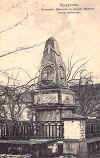 |
|
We finish our excursion in Irkutsk historical center. Undoubtedly, our
story is not complete, but we hope that even some pages from the past and present of
Eastern Siberian Capital have interested our city future guests. |
|
![]()
![]()
![]()
![]()